SSANGYONG KORANDO 1997 Service Repair Manual
Manufacturer: SSANGYONG, Model Year: 1997, Model line: KORANDO, Model: SSANGYONG KORANDO 1997Pages: 2053, PDF Size: 88.33 MB
Page 241 of 2053

1F1 -- 78 M162 ENGINE CONTROLS
D AEW OO M Y_2000
ENGINE RPM
KAB1F330
Failure
CodeDescriptionTrouble AreaMaintenance Hint
32
Engine rpm output
circuit short circuit to
battery
When short circuit to battery
DMonitoring the actual rpm in cluster
DInspection the Engine Control Module
(ECM) pin 60 about short circuit or
open
33
Engine rpm output
circuit short circuit to
ground or openWhen short circuit to ground
or open
open
DInspection the cluster panel board
circuit
DInspection the ECM
Page 242 of 2053

M162 ENGINE CONTROLS 1F1 -- 79
D AEW OO M Y_2000
EXHAUST SYSTEM
CATALYTIC CONVERTER
The purpose of the catalytic converter is to convert the three pollutants of carbon monoxide (CO), hydrocarbons (HC)
and oxides of nitrogen (NOx) contained in the exhaust of gasoline engines, into the harmless compounds of water
(H2O), carbon dioxide (CO2) and nitrogen (N2).
The catalytic converter contains a catalyst, a word coming from the Greek and which designates the element essential
for catalyst which triggers chemical reactions without itself being consumed.
These catalysts in the 3 -- way catalytic converter are the rare metals platinum (Pt) and rhodium (Rh).
The catalytic converter consists essentially of three main elements. The exhaust gases flow through the catalytic con-
verter and, in so doing, coming into contact with rare metals (Pt and Rh).
The following chemical reaction are produced.
CO + O2→CO2
HC + O2→CO2 + H2O
NOx→N2 + O2
Page 243 of 2053
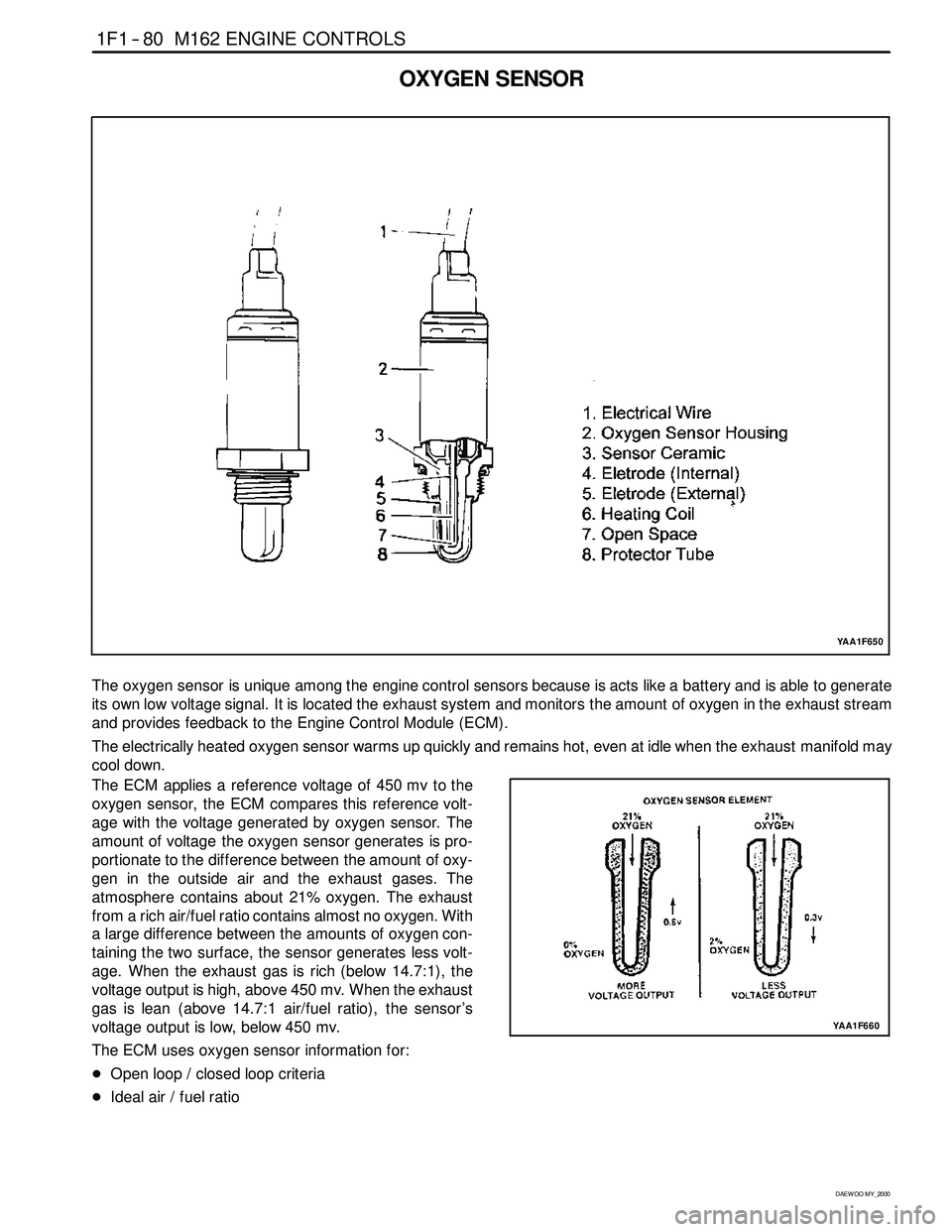
1F1 -- 80 M162 ENGINE CONTROLS
D AEW OO M Y_2000
OXYGEN SENSOR
YAA1F650
The oxygen sensor is unique among the engine control sensors because is acts like a battery and is able to generate
its own low voltage signal. It is located the exhaust system and monitors the amount of oxygen in the exhaust stream
and provides feedback to the Engine Control Module (ECM).
The electrically heated oxygen sensor warms up quickly and remains hot, even at idle when the exhaust manifold may
cool down.
The ECM applies a reference voltage of 450 mv to the
oxygen sensor, the ECM compares this reference volt-
age with the voltage generated by oxygen sensor. The
amount of voltage the oxygen sensor generates is pro-
portionate to the difference between the amount of oxy-
gen in the outside air and the exhaust gases. The
atmosphere contains about 21% oxygen. The exhaust
from a rich air/fuel ratio contains almost no oxygen. With
a large difference between the amounts of oxygen con-
taining the two surface, the sensor generates less volt-
age. When the exhaust gas is rich (below 14.7:1), the
voltage output is high, above 450 mv. When the exhaust
gas is lean (above 14.7:1 air/fuel ratio), the sensor ’s
voltage output is low, below 450 mv.
The ECM uses oxygen sensor information for:
DOpen loop / closed loop criteria
DIdeal air / fuel ratio
YAA1F660
Page 244 of 2053

M162 ENGINE CONTROLS 1F1 -- 81
D AEW OO M Y_2000
YAA1F670
Page 245 of 2053
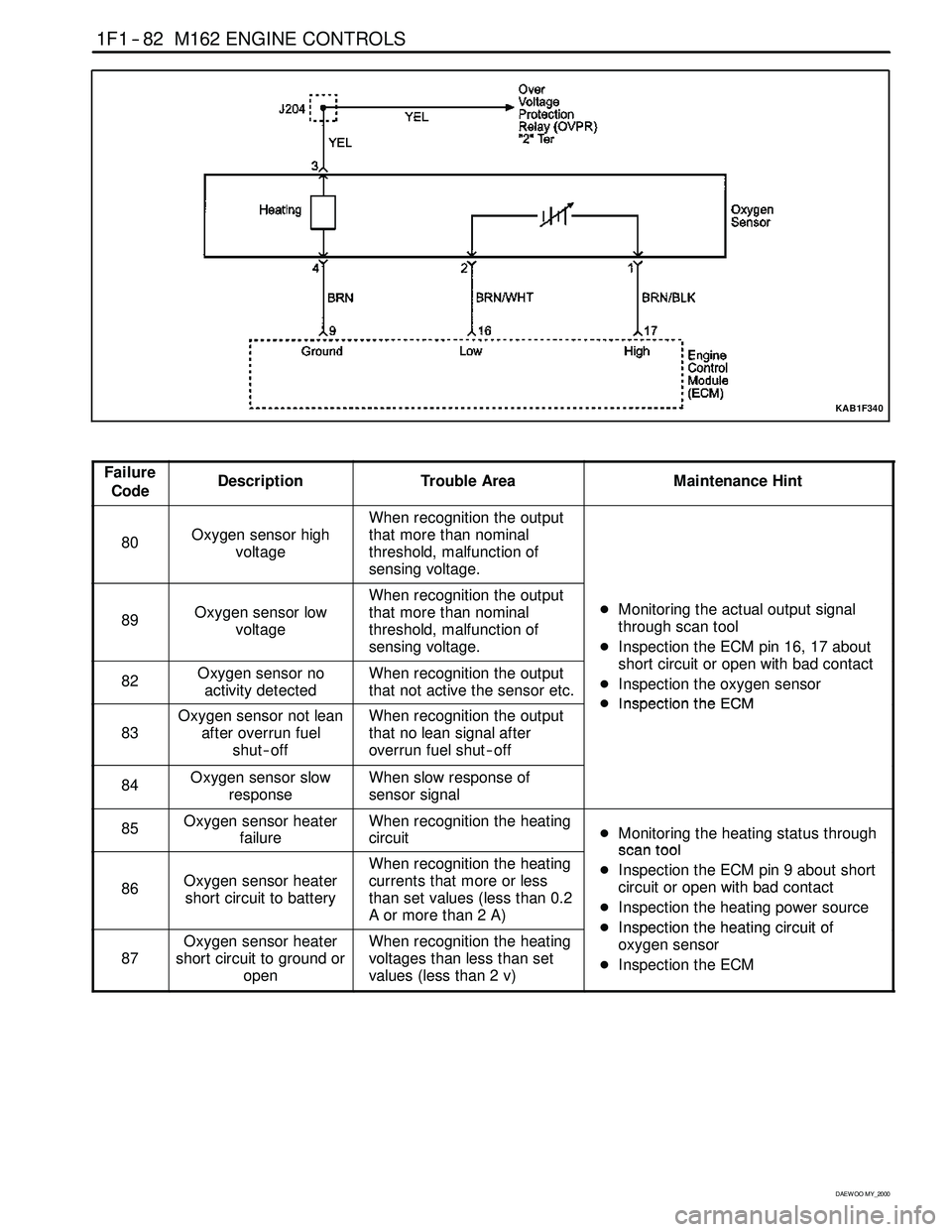
1F1 -- 82 M162 ENGINE CONTROLS
D AEW OO M Y_2000
KAB1F340
Failure
CodeDescriptionTrouble AreaMaintenance Hint
80Oxygen sensor high
voltage
When recognition the output
that more than nominal
threshold, malfunction of
sensing voltage.
89Oxygen sensor low
voltage
When recognition the output
that more than nominal
threshold, malfunction of
sensing voltage.DMonitoring the actual output signal
through scan tool
DInspection the ECM pin 16, 17 about
htiitithbdtt
82Oxygen sensor no
activity detectedWhen recognition the output
that not active the sensor etc.short circuit or open with bad contact
DInspection the oxygen sensor
DInspectiontheECM
83
Oxygen sensor not lean
after overrun fuel
shut -- offWhen recognition the output
that no lean signal after
overrun fuel shut -- offDInspectiontheECM
84Oxygen sensor slow
responseWhen slow response of
sensor signal
85Oxygen sensor heater
failureWhen recognition the heating
circuitDMonitoring the heating status through
scantool
86Oxygen sensor heater
short circuit to battery
When recognition the heating
currents that more or less
than set values (less than 0.2
Aormorethan2A)scantool
DInspection the ECM pin 9 about short
circuit or open with bad contact
DInspection the heating power source
DInspectiontheheatingcircuitof
87
Oxygen sensor heater
short circuit to ground or
openWhen recognition the heating
voltages than less than set
values (less than 2 v)DInspectiontheheating circuitof
oxygen sensor
DInspection the ECM
Page 246 of 2053
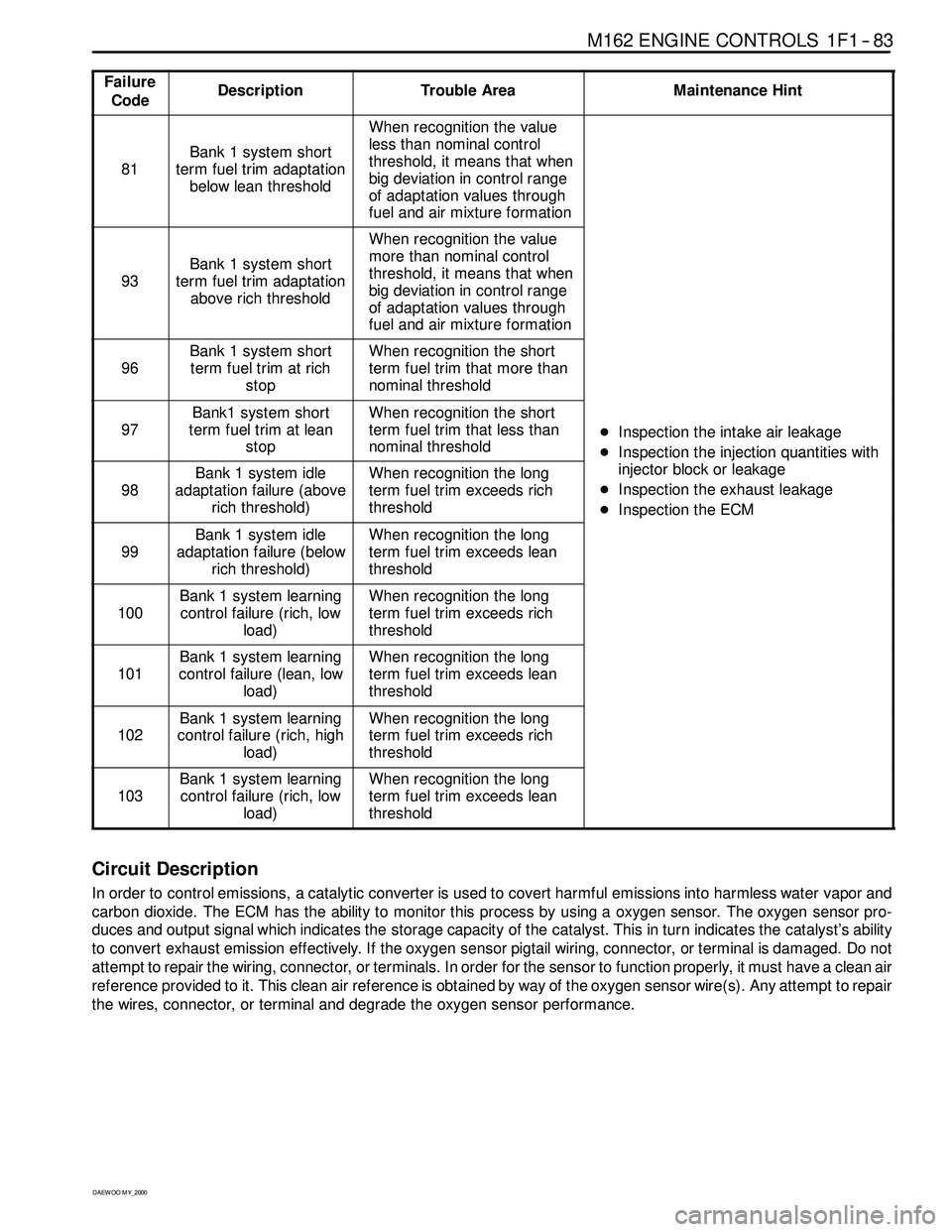
M162 ENGINE CONTROLS 1F1 -- 83
D AEW OO M Y_2000
Failure
CodeDescriptionTrouble AreaMaintenance Hint
81
Bank 1 system short
term fuel trim adaptation
below lean threshold
When recognition the value
less than nominal control
threshold, it means that when
big deviation in control range
of adaptation values through
fuel and air mixture formation
93
Bank 1 system short
term fuel trim adaptation
above rich threshold
When recognition the value
more than nominal control
threshold, it means that when
big deviation in control range
of adaptation values through
fuel and air mixture formation
96
Bank 1 system short
term fuel trim at rich
stopWhen recognition the short
term fuel trim that more than
nominal threshold
97
Bank1 system short
term fuel trim at lean
stopWhen recognition the short
term fuel trim that less than
nominal threshold
DInspection the intake air leakage
DIns
pection the injectionquantities with
98
Bank 1 system idle
adaptation failure (above
rich threshold)When recognition the long
term fuel trim exceeds rich
threshold
DInspectiontheinjectionquantitieswith
injector block or leakage
DInspection the exhaust leakage
DInspection the ECM
99
Bank 1 system idle
adaptation failure (below
rich threshold)When recognition the long
term fuel trim exceeds lean
threshold
p
100
Bank 1 system learning
control failure (rich, low
load)When recognition the long
term fuel trim exceeds rich
threshold
101
Bank 1 system learning
control failure (lean, low
load)When recognition the long
term fuel trim exceeds lean
threshold
102
Bank 1 system learning
control failure (rich, high
load)When recognition the long
term fuel trim exceeds rich
threshold
103
Bank 1 system learning
control failure (rich, low
load)When recognition the long
term fuel trim exceeds lean
threshold
Circuit Description
In order to control emissions, a catalytic converter is used to covert harmful emissions into harmless water vapor and
carbon dioxide. The ECM has the ability to monitor this process by using a oxygen sensor. The oxygen sensor pro-
duces and output signal which indicates the storage capacity of the catalyst. This in turn indicates the catalyst’s ability
to convert exhaust emission effectively. If the oxygen sensor pigtail wiring, connector, or terminal is damaged. Do not
attempt to repair the wiring, connector, or terminals. In order for the sensor to function properly, it must have a clean air
reference provided to it. This clean air reference is obtained by way of the oxygen sensor wire(s). Any attempt to repair
the wires, connector, or terminal and degrade the oxygen sensor performance.
Page 247 of 2053
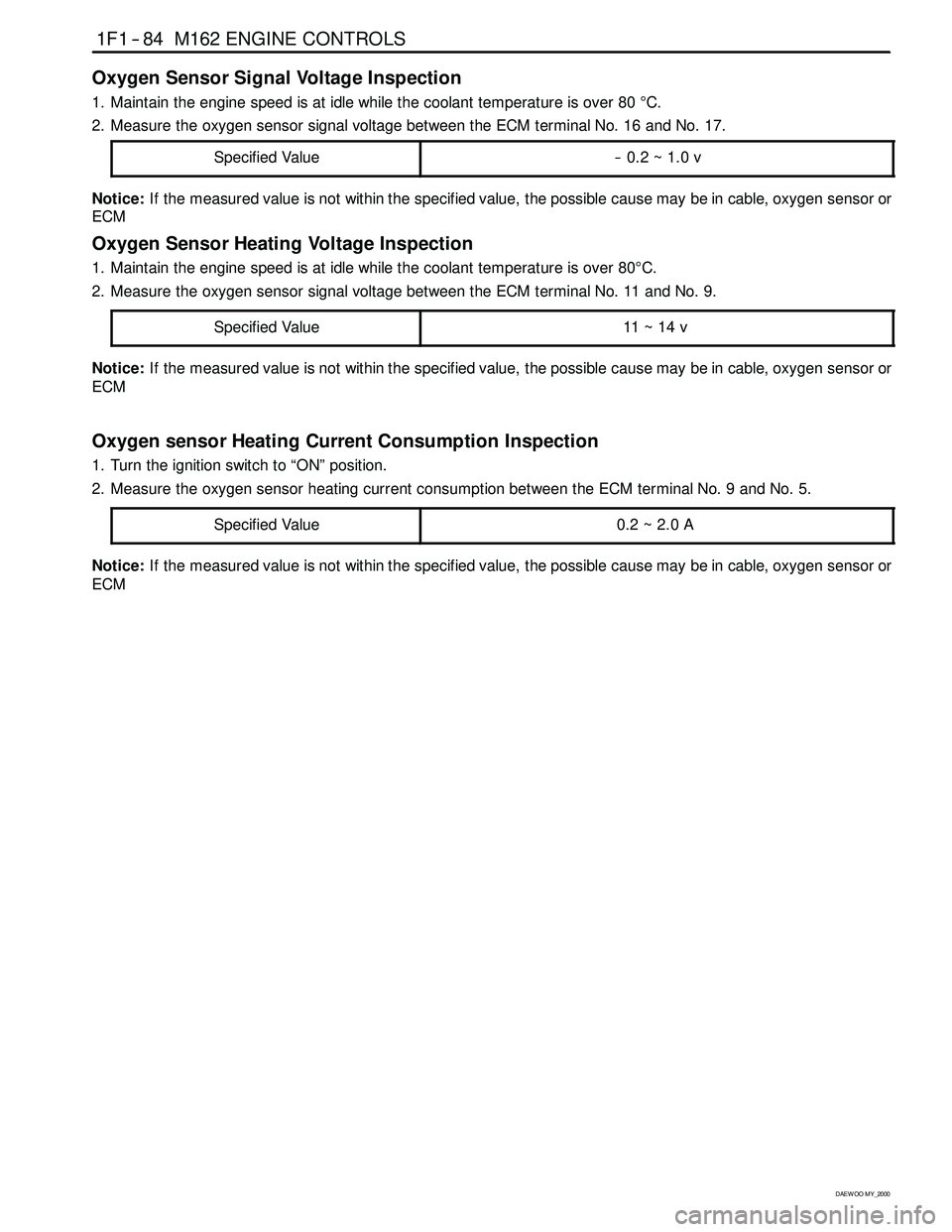
1F1 -- 84 M162 ENGINE CONTROLS
D AEW OO M Y_2000
Oxygen Sensor Signal Voltage Inspection
1. Maintain the engine speed is at idle while the coolant temperature is over 80°C.
2. Measure the oxygen sensor signal voltage between the ECM terminal No. 16 and No. 17.
Specified Value
-- 0.2 ~ 1.0 v
Notice:If the measured value is not within the specified value, the possible cause may be in cable, oxygen sensor or
ECM
Oxygen Sensor Heating Voltage Inspection
1. Maintain the engine speed is at idle while the coolant temperature is over 80°C.
2. Measure the oxygen sensor signal voltage between the ECM terminal No. 11 and No. 9.
Specified Value
11 ~ 14 v
Notice:If the measured value is not within the specified value, the possible cause may be in cable, oxygen sensor or
ECM
Oxygen sensor Heating Current Consumption Inspection
1. Turn the ignition switch to “ON” position.
2. Measure the oxygen sensor heating current consumption between the ECM terminal No. 9 and No. 5.
Specified Value
0.2~2.0A
Notice:If the measured value is not within the specified value, the possible cause may be in cable, oxygen sensor or
ECM
Page 248 of 2053

M162 ENGINE CONTROLS 1F1 -- 85
D AEW OO M Y_2000
BLANK
Page 249 of 2053
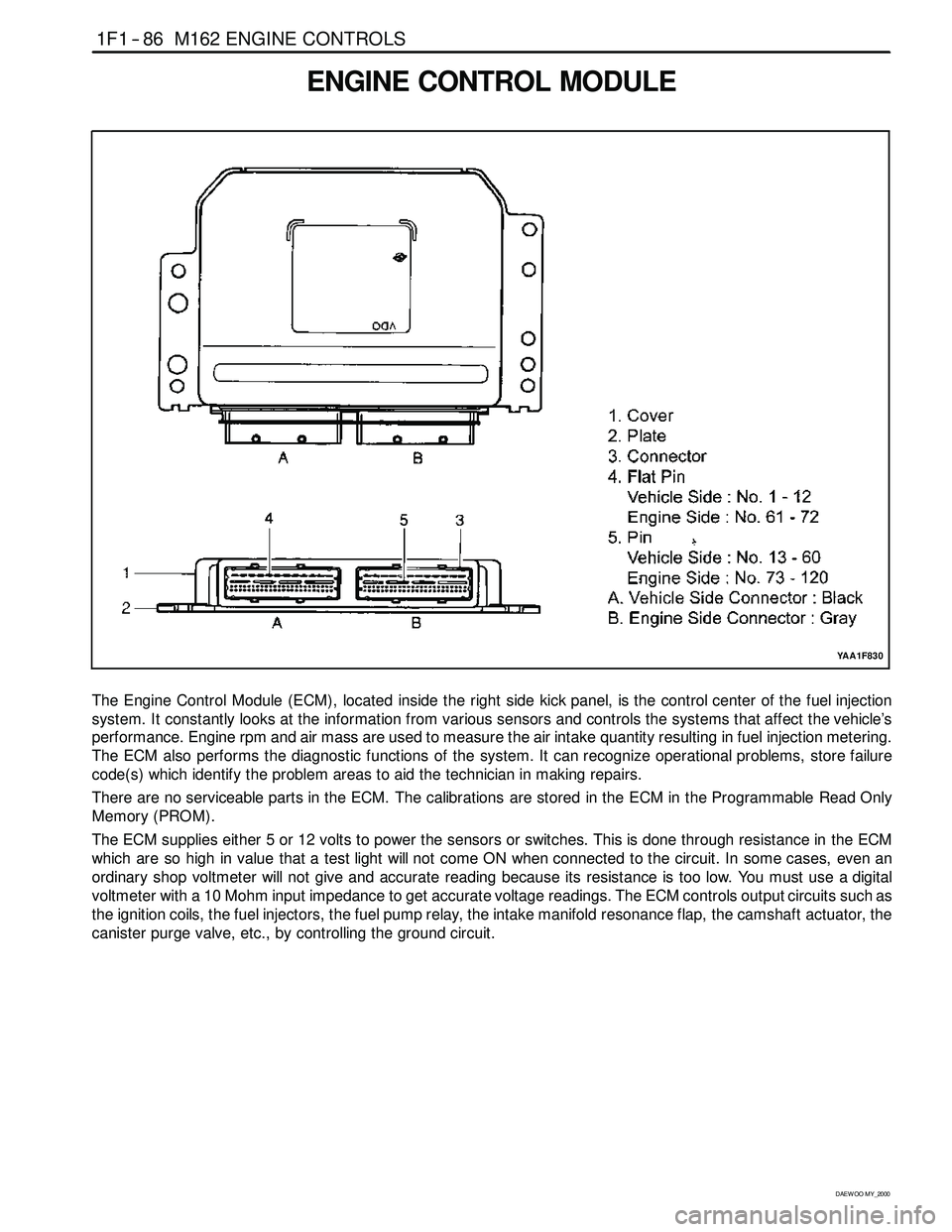
1F1 -- 86 M162 ENGINE CONTROLS
D AEW OO M Y_2000
ENGINE CONTROL MODULE
YAA1F830
The Engine Control Module (ECM), located inside the right side kick panel, is the control center of the fuel injection
system. It constantly looks at the information from various sensors and controls the systems that affect the vehicle’s
performance. Engine rpm and air mass are used to measure the air intake quantity resulting in fuel injection metering.
The ECM also performs the diagnostic functions of the system. It can recognize operational problems, store failure
code(s) which identify the problem areas to aid the technician in making repairs.
There are no serviceable parts in the ECM. The calibrations are stored in the ECM in the Programmable Read Only
Memory (PROM).
The ECM supplies either 5 or 12 volts to power the sensors or switches. This is done through resistance in the ECM
which are so high in value that a test light will not come ON when connected to the circuit. In some cases, even an
ordinary shop voltmeter will not give and accurate reading because its resistance is too low. You must use a digital
voltmeter with a 10 Mohm input impedance to get accurate voltage readings. The ECM controls output circuits such as
the ignition coils, the fuel injectors, the fuel pump relay, the intake manifold resonance flap, the camshaft actuator, the
canister purge valve, etc., by controlling the ground circuit.
Page 250 of 2053

M162 ENGINE CONTROLS 1F1 -- 87
D AEW OO M Y_2000
BLANK